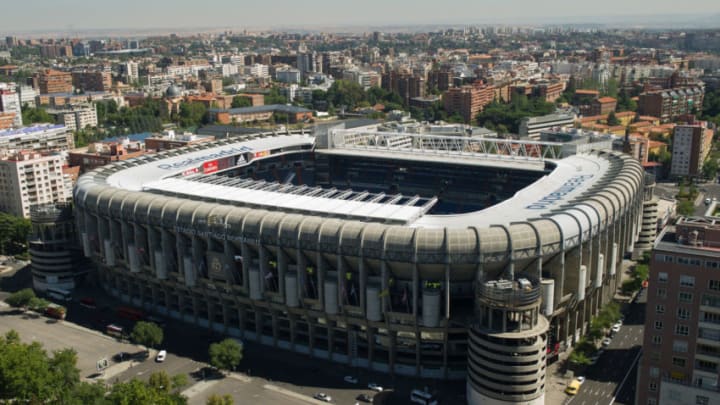
The house Santiago built
It took six months for the club to repair the Charmatin to working order again, just in time to host city rivals Atlético Aviación (now Atletico Madrid) in October 1939. Los Blancos won the match by two goals in front of a crowd of 22,000 people. When Santiago Bernabeu was elected president in 1943, he quickly set about chasing a dream for the club he had had since he was club secretary in 1931, a 100,000 seater stadium.
At the time, the idea was seemed insane, as Bernabeu acknowledged in a later interview “the idea of a gigantic new stadium for ‘little’ Real Madrid at the time was widely described as nonsensical.” When Bernabeu sent his first proposal for the stadium, Madrid had narrowly survived relegation. They averaged just over 16,000 supporters and showed few signs of improving any time soon. Spain itself was in crisis, rebuilding from their own Civil War in the midst of the Second World War.
Real Madrid's Campo de Chamartin in 1944/45, as work begins on their current home next door. pic.twitter.com/Ysfte0IdS8
— Estadios de España (@estadios_Spain) November 17, 2018
Bernabeu’s first proposal was naturally rejected, but the government did agree to fund five percent of 30 million cost to build the stadium. Through the selling of bonds to both club members and fans and calling in all the connections Bernabeu had made both in the Spanish government and in private Spanish companies, he was able to cobble enough money together to build the Neuvo Charmatin. Work began in October 1944 and was complete by Christmas 1947, the old Charmatin was knocked down in the building process.
Though looking insane at the time, it proved to be quite a shrewd move from Madrid’s president. Bernabeu had the stadium built on the Castellana which is now Madrid’s most glamorous sector. Charging fifteen pesetas for a ticket, a ludicrous price considering the cost of the stadium, Madrid saw its fanbase grow exponentially. The club added 8,000 new members to its ranks within the next three months. By 1948, the club had 43,000 members. Using the revenue made from ticket sells, Bernabeu was able to achieve his second ambition, bringing the world’s best players to Madrid, a move he was certain would see the club win silverware.
Images from the inaugural match at the Estadio Santiago Bernabéu (14/12/1947)https://t.co/55k5ZdKr6h pic.twitter.com/xPLg3S82bM
— Estadios de España (@estadios_Spain) December 14, 2015
Bernabeu continued to tinker with the stadium’s design. In 1952, the stadium had its capacity was increased to 125,000. Three years later, the board unamiously voted to have the Neuvo Charmatin’s name changed to the Estadio Santiago Bernabeu, in honour to the man who had built it. During his 35-year presidency, Real Madrid won 71 trophies, Bernabeu’s stadium gamble had paid off more than he could ever imagine.
